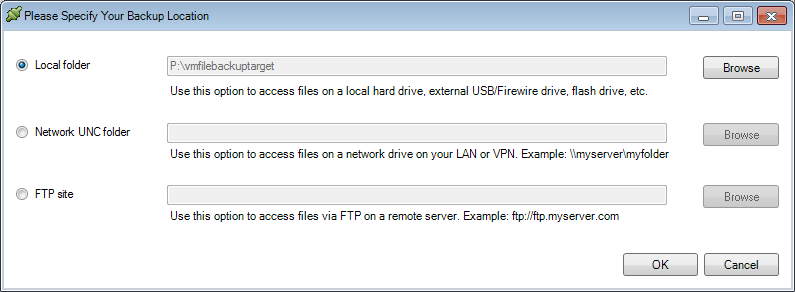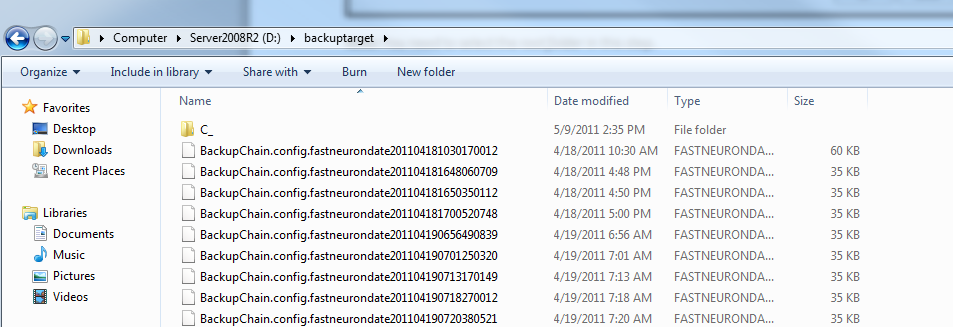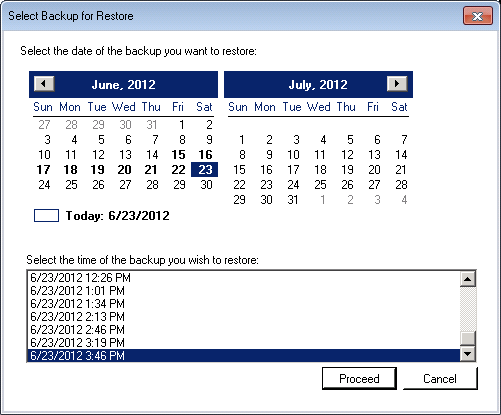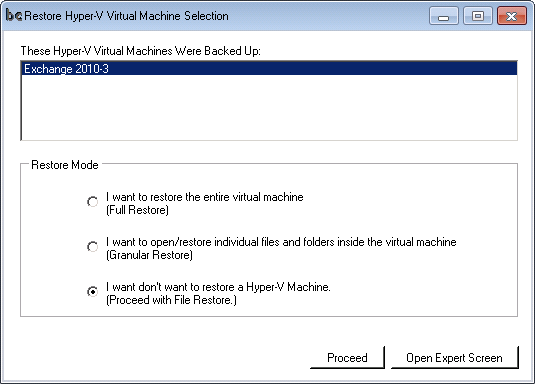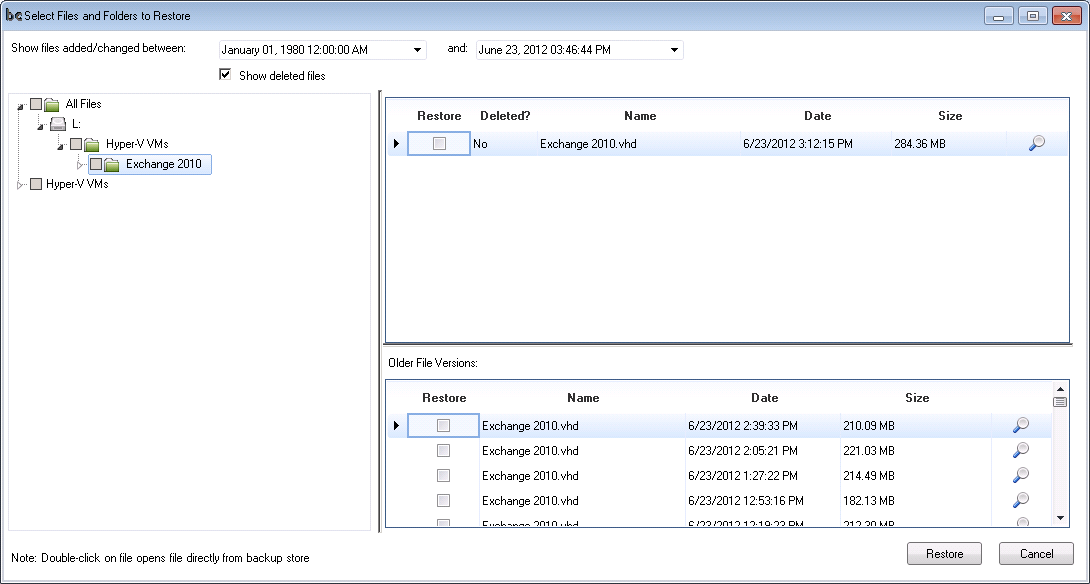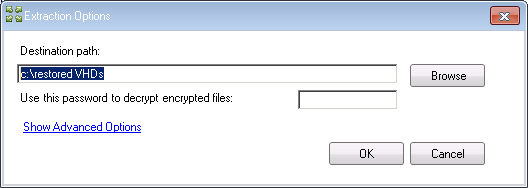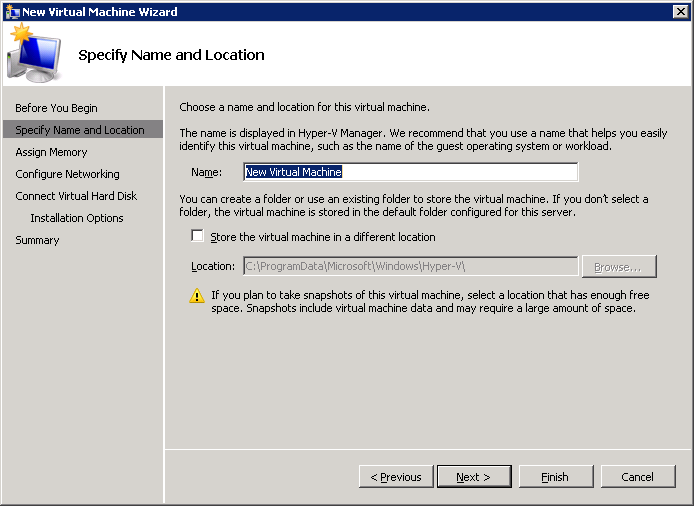How to Restore a File Based Backup of Hyper-V
To restore a Hyper-V virtual machine using the standard file restore process, select the backup task from the Backup Task List (unless restoring on a new machine) and select Restore from the main menu. Proceed with Restore Files and Folders:
Then you need to fill in the details about the backup location. This information is usually preset with the task settings:
Note: You need to select the root folder in this step.
If you open the folder in Windows Explorer, the root folder may look like this:
Notice the C_ folder (for C: drive) and the BackupChain.config files. These files are necessary for restore operations.
Proceed and the backup set selection opens:
Either click Cancel to obtain the full view of all existing backups, or select a particular day and time.
Once you select a restore point you will be presented with the option to automatically restore the entire Hyper-V virtual machine, the option to open Granular Restore (available only in BackupChain Server Enterprise Edition), or to proceed with File Restore. In this tutorial we choose File Restore:
Proceed and click OK and the Restore Screen opens:
Navigate to the folder containing the virtual machine files and check the folder. This will restore all files within this folder as well as all subfolders. The restore process will restore the latest version of each file in the folder. The “latest version” is determined by the date filter at the top of the restore screen. Now proceed by clicking Restore.
If the virtual machine contains snapshots, you need to restore all the files to the same folder, such as C:\VHD. WARNING: Even though the default restore setting does not overwrite files without your permission, you still need to be careful not to overwrite files accidentally!
Click OK and let the restore process finish.
Now add a new Hyper-V machine via the Server Manager and connect to the existing virtual disk:
Try to assign the same or similar settings, such as number of CPUs and RAM, and start the machine.
Backup Software Overview
The Best Backup Software in 2025 Download BackupChain®BackupChain is the all-in-one server backup software for:
Server Backup
Disk Image Backup
Drive Cloning and Disk Copy
VirtualBox Backup
VMware Backup
Image Backup
FTP Backup
Cloud Backup
File Server Backup
Virtual Machine Backup
BackupChain Server Backup Solution
Hyper-V Backup
Popular
- Best Practices for Server Backups
- NAS Backup: Buffalo, Drobo, Synology
- How to use BackupChain for Cloud and Remote
- DriveMaker: Map FTP, SFTP, S3 Sites to a Drive Letter (Freeware)
Resources
- BackupChain
- VM Backup
- V4 Articles
- Knowledge Base
- FAQ
- BackupChain (German)
- German Help Pages
- BackupChain (Greek)
- BackupChain (Spanish)
- BackupChain (French)
- BackupChain (Dutch)
- BackupChain (Italian)
- Backup.education
- Sitemap
- BackupChain is an all-in-one, reliable backup solution for Windows and Hyper-V that is more affordable than Veeam, Acronis, and Altaro.
Other Backup How-To Guides
- BackupChain v2.4.531 Released!
- 18 Pros and Cons of External Hard Drives
- Backup Software Without Compression Option: As-Is File Backup
- Free SFTP + FTP Client, Map Network Drive for SFTP & FTP
- Windows 10 (Final) Download Link Enterprise Trial / Evaluation
- Alternatives to Acronis, Veeam, Backup Exec, and Microsoft DPM
- How to Fix Hyper-V Backup Errors
- Notable Customers
- How to Map FTP as a Network Drive on Windows 11-10
- Copy Long Path Names and Deep Folders over 240 Characters
- USB Disks and Hyper-V: How to Use, Pros and Cons
- V2V Converter & Backup for Hyper-V VMware VirtualBox
- Hyper-V Fixed Disks: Pros and Cons
- BackupChain Backup Software Rewards for MSPs and Users
- How to Backup Hyper-V Guest Machine Server While Running Video
- Command-line Access S3, FTP, Wasabi, SFTP, Cloud Drive Windows
- How to P2V for Hyper-V 2012 Using Disk2VHD in VHDX Format
- Protection Against Ransomware, CryptoLocker, Trojans and Viruses
- Set Up Private DIY Cloud Server Storage and Access via Mapped Drive
- What’s New in v3.0.768?



